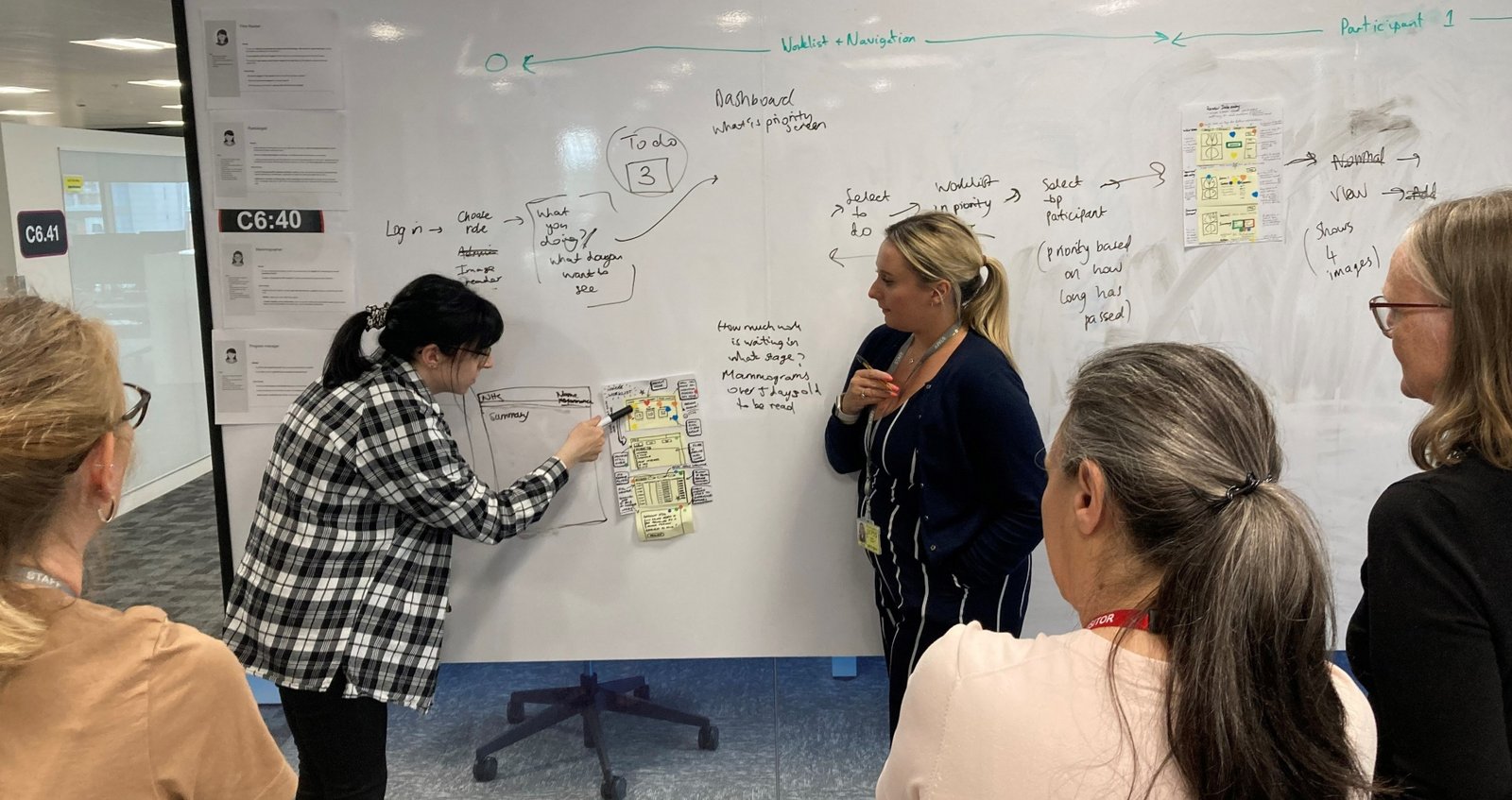Each year, millions of screening appointments are attended across England and thousands of lives are estimated to be saved thanks to early detection and treatment.
Multiple services are covered by the national screening programme, such as diabetic eye screening as well as the 3 national cancer screening programmes (breast, cervical and bowel). NHS Digital provides the IT systems that underpin all these screening services.
We know that the systems involved need to be improved: staff have told us they can be difficult to navigate and patients have told us that the process feels like it takes too long. That’s why, in the Digital Transformation of Screening programme, we aim to make it easier for staff to run screening services and for the public to take up screening.
The task is huge. There are numerous IT systems that need to be redesigned and deployed nationally. We want to do this in the right way so that the products we build can be used for other health services.
A design sprint should focus on a big, but manageable, problem to solve.
We’ve done a lot of research and planning, but recently we decided to fast-track some of our activity going from discovery to alpha.
We decided to run a design sprint, using the Google Ventures (now GV) methodology and focusing on one of several digital products we’ve identified for screening, which we’re calling ‘screening event manager’.
For the sprint, we decided to focus on breast screening, but still tried to make sure that what we designed could be used for other screening services.
Why screening event manager?
A design sprint should focus on a big, but manageable, problem to solve.
‘Screening event manager’ captures the various steps participants go through, all the way from getting their invitation to screening, to getting their result. It is one of the most complex future components of the screening system we’re looking at.
It’s intended to hold screening participants’ information, such as medical history and screening results, in one place, and we know that currently, this information is split between multiple systems. We’ve learnt this from site visits to breast screening offices and user research discoveries we’ve completed across various screening programmes.
The insights we’ve gained into user needs and pain points all fed into this design sprint, and the intention is for ‘screening event manager’ to resolve many of the issues we’ve found. But there are still many questions to be answered. Hence why it became the focus of our sprint.
Putting a team together
Some of us in the team had been part of or facilitated a design sprint before so we had the skills we needed. We knew a multidisciplinary team would bring the best out of a design sprint, so we included a:
- product manager
- delivery manager
- service designer
- interaction designer
- content designer
- clinical users / subject matter experts
- technical architect
- user researcher
- facilitator
Getting clinical experts involved is vital to delivering a design sprint in NHS Digital as they help to put everything in context of the clinical delivery and help us to ensure what we are creating is realistic. We were lucky enough to have 2 senior practicing clinicians join the sprint to balance each other and give different thoughts. We worked with their limited availability to maximise their input.
Our senior responsible officer was keen to be involved too to help us kick off the sprint, setting a long-term goal. This was a great encouragement for the sprint team, and it gave us a clear direction.
Quick input through lightning talks
On day 1 of the sprint, we invited expert colleagues to do lightning talks and give us some detail on how screening events are currently managed, to help set the scene for the sprint. We all recorded ‘how might we’ statements while listening to the talks, which helped us narrow down the problems we might want to tackle in our sprint. For example, ‘how might we provide users access to mammogram pictures taken at a previous screening appointment?’
The talks also helped us understand the technology and the users in a short space of time. Like the name suggests, sprints are all about speed.
Mapping it all out
We then moved on to creating a simple map of the future user journey, which had no more than 15 steps. We sorted our ‘how might we’ statements into themes and plotted them on the map. This exercise helped us agree what the target of our sprint would be.
The user type we decided to focus on was ‘image readers’ – the people who analyse mammogram pictures taken during screening. Our 2 focuses were:
- the reading, analysis and submitting of the outcome of mammography images
- identifying the worklist and how work is allocated to each clinician trained to read mammogram images
Let’s prototype
After jotting down notes individually, we each took pen to paper and took part in a ‘Crazy 8s’ exercise and solution sketching. Each person folded their sheet of paper into 8 frames and spent 1 minute per square to quickly draw out ideas. Then, we each created a ‘solution sketch’ consisting of our best idea, before sticking them all up on the wall to form our own art gallery to review as a team. We each voted and came to a decision on which idea to take forward to prototype and test with users.
From this, we created a storyboard of the prototype based on the winning idea, working collaboratively to design the flow screen by screen. We then turned this into a realistic, clickable journey using prototyping software.
Getting our users involved
Our first design principle is to put people at the heart of everything we do. We quickly identified that we needed to speak to radiologists and radiographers to get feedback on the prototype. They are some of the busier clinicians within screening, which posed a challenge due to the fast pace of the sprint.
We were told we needed to give at least 6 weeks’ notice to recruit clinical users for user research, but thanks to the clinicians on the team and colleagues in NHS England and NHS Improvement we managed to speak to 4 participants in the first round of testing.
Time to iterate
After our first round of usability testing, we created a set of ‘how might we’ statements based on what we observed – for example, ‘how might we make sure users have the clinical information they need in an easily accessible way?’ These statements helped us to articulate what problems to focus on for our next round of testing. We decided as a team which statements to prioritise and got to work ideating and making changes to the prototype.
We created a version 2 to test with users the following day, to see whether the iterations we had made met their needs.
What we’d change next time
Due to other activities happening at the same time, we ran this design sprint slightly differently to how we normally would. But we’ve learnt a lot from it and we’re already planning our next design sprint.
-
run a shorter sprint (this one was 10 days long) – now that we’ve done one, we know we can run a shorter sprint and achieve almost as much -
start thinking about user recruitment early on so we can recruit users from more parts of the country – this can be hard in a sprint due to choosing the target within the sprint, but with clinical users we need to allow for more time -
get more people from other programmes involved – there are opportunities for us to involve others from across the organisation to help us with the service design
What’s next?
In just a few days of hard work we went from high-level ideas and a lot of questions and unknowns to a clickable prototype to test with users. We got some positive feedback from users and learnt what to improve.
Our stakeholders were very enthusiastic about the exercise and how much we achieved during the short space of time, and the collaborative way of working between team members of all different backgrounds and specialisms.
We are now working on a version 3 of our prototype following the design sprint and are planning to recruit users to test it with.
This is just one area of what we are doing in the Digital Transformation of Screening programme, but it has helped us to accelerate our work, build confidence in stakeholders, and quickly engage with users. We’re currently planning our next design sprint to tackle another problem.
If you want to get in touch or ask any more questions about our work, you can email us at [email protected]
Related subjects
Share this page
Authors
Latest blogs
Last edited: 1 August 2022 2:32 pm
Source: digital.nhs.uk







 Please wait...
Please wait...

Add comment